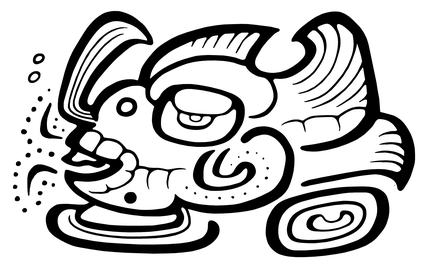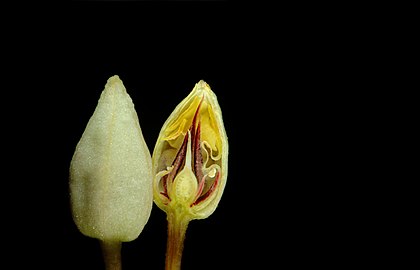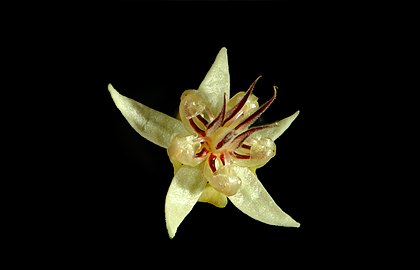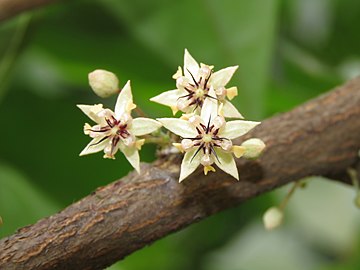Theobroma cacao
| Theobroma cacao | |
|---|---|
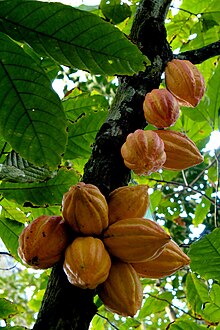
| |
| Cacao fruits on the tree | |
| Scientific classification | |
| Kingdom: | Plantae |
| Clade: | Tracheophytes |
| Clade: | Angiosperms |
| Clade: | Eudicots |
| Clade: | Rosids |
| Order: | Malvales |
| Family: | Malvaceae |
| Genus: | Theobroma |
| Species: | T. cacao
|
| Binomial name | |
| Theobroma cacao | |
| Synonyms[1][2] | |
| |
Theobroma cacao (cacao tree or cocoa tree) is a small (6–12 m (20–39 ft) tall) evergreen tree in the family Malvaceae.[1][3] Its seeds, cocoa beans, are used to make chocolate liquor, cocoa solids, cocoa butter and chocolate.[4] Native to the tropics of the Americas, the largest producer of cocoa beans in 2018 was Ivory Coast, at 2.2 million tons. Its leaves are alternate, entire, unlobed, 10–50 cm (4–20 in) long and 5–10 cm (2–4 in) broad.
Description
Flowers
The
While many of the world's flowers are pollinated by
Fruit
The fruit, called a cacao pod, is ovoid, 15–30 cm (6–12 in) long and 8–10 cm (3–4 in) wide, ripening yellow to orange, and weighs about 500 g (1 lb) when ripe. The pod contains 20 to 60 seeds, usually called "beans", embedded in a white pulp.
The seeds are the main ingredient of
The fruit's active constituent is the stimulant theobromine, a compound similar to caffeine.[9]
Nomenclature
The generic name Theobroma is derived from the Greek for "food of the gods"; from θεός (theos), meaning 'god' or 'divine', and βρῶμα (broma), meaning 'food'. The specific name cacao is the Hispanization of the name given to the plant in indigenous Mesoamerican languages such as kakaw in Tzeltal, Kʼicheʼ and Classic Maya; kagaw in Sayula Popoluca; and cacahuatl in Nahuatl meaning "bean of the cocoa-tree".[10]
Taxonomy
Cacao (Theobroma cacao) is one of 26 species belonging to the genus Theobroma classified under the subfamily Byttnerioideae of the mallow family Malvaceae.[1]
In 2008, researchers proposed a new classification based upon
Distribution and domestication
T. cacao is widely distributed from southeastern
Cacao trees grow well as understory plants in humid forest ecosystems. This is equally true of abandoned cultivated trees, making it difficult to distinguish truly wild trees from those whose parents may originally have been cultivated.[citation needed]
Currency system
Cacao beans constituted both a ritual beverage and a major
Cultivation
In 2016, cocoa beans were cultivated on roughly 10,196,725 hectares (25,196,660 acres) worldwide.[17] Cocoa beans are grown by large agroindustrial plantations and small producers, the bulk of production coming from millions of farmers with small plots.[18] A tree begins to bear when it is four or five years old. A mature tree may have 6,000 flowers in a year, yet only about 20 pods. About 1,200 seeds (40 pods) are required to produce 1 kg (2.2 lb) of cocoa paste.
Historically, chocolate makers have recognized three main cultivar groups of cacao beans used to make cocoa and chocolate: Forastero, Criollo and Trinitario.[19] The most prized, rare, and expensive is the Criollo group, the cocoa bean used by the Maya. Only 10% of chocolate is made from Criollo, which is arguably less bitter and more aromatic than any other bean. In November 2000, the cacao beans coming from Chuao were awarded an appellation of origin under the title Cacao de Chuao (from Spanish: 'cacao of Chuao').[20]
The cacao bean in 80% of chocolate is made using beans of the Forastero group, the main and most ubiquitous variety being the Amenolado variety, while the Arriba variety (such as the Nacional variety) are less commonly found in Forastero produce. Forastero trees are significantly hardier and more disease-resistant than Criollo trees, resulting in cheaper cacao beans.[21]
Major cocoa bean processors include
Production
| Country | Production (tonnes) |
|---|---|
| 1,963,949 | |
| 947,632 | |
| 593,832 | |
| 332,927 | |
| 307,867 | |
| 239,387 | |
| World | 5,252,377 |
| Source: FAOSTAT of the United Nations[23]
| |
In 2018, world production of cocoa beans was 5.3 million metric tons (5.8 million short tons), led by Ivory Coast with 37% of the total. Other major producers were Ghana (18%) and Indonesia (11%).[23]
Conservation
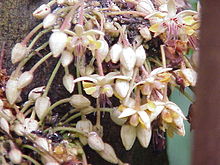
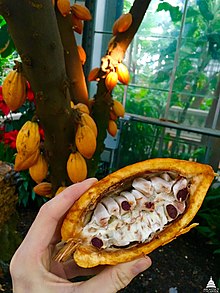
The pests and diseases to which cacao is subject, along with climate change, mean that new varieties will be needed to respond to these challenges. Breeders rely on the genetic diversity conserved in field
Phytopathogens (parasitic organisms) cause much damage to Theobroma cacao plantations around the world. Many of those phytopathogens, which include many of the pests named below, were analyzed using mass spectrometry and allow for guiding on the correct approaches to get rid of the specific phytopathogens. This method was found to be quick, reproducible, and accurate showing promising results in the future to prevent damage to Theobroma cacao by various phytopathogens.[26]
A specific bacterium Streptomyces camerooniansis was found to be beneficial for T. cacao by helping plant growth by accelerating seed germination of T. cacao, inhibiting growth of various types of microorganisms (such as different oomycetes, fungi, and bacteria), and preventing rotting by Phytophthora megakarya.[27]
Pests
Various plant pests and diseases can cause serious problems for cacao production.[28]
- Insects
- Cocoa mirids or capsids worldwide (but especially Sahlbergella singularis and Distantiella theobroma in West Africa and Helopeltis spp. in Southeast Asia)
- Bathycoelia thalassina - West Africa
- Conopomorpha cramerella (cocoa pod borer – in Southeast Asia)
- Carmenta theobromae - C. & S. America
- Fungi
- Moniliophthora roreri (frosty pod rot)
- Moniliophthora perniciosa (witches' broom)
- Ceratocystis cacaofunesta (mal de machete) or (Ceratocystis wilt)
- Verticillium dahliae
- Oncobasidium theobromae(vascular streak dieback)
- Oomycetes
- Phytophthora spp. (black pod) especially Phytophthora megakarya in West Africa
- Viruses
- Mistletoe
- Rats and other vertebrate pests (squirrels, woodpeckers, etc.)
Genome
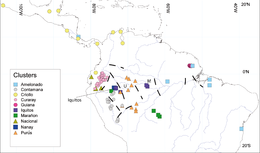 Map showing genetic clusters of Theobroma cacao | |
| NCBI genome ID | 572 |
|---|---|
| Ploidy | diploid |
| Genome size | 345.99 Mb |
| Number of chromosomes | 10 pairs |
| Year of completion | 2010 |
The genome of T. cacao is diploid, its size is 430 Mbp, and it comprises 10 chromosome pairs (2n=2x=20). In September 2010, a team of scientists announced a draft sequence of the cacao genome (Matina1-6 genotype).[29] In a second, unrelated project, the International Cocoa Genome Sequencing Consortium-ICGS, coordinated by CIRAD,[30] first published[31] in December 2010 (online, paper publication in January 2011), the sequence of the cacao genome, of the Criollo cacao (of a landrace from Belize, B97-61/B2). In their publication, they reported a detailed analysis of the genomic and genetic data.
The sequence of the cacao genome identified 28,798 protein-coding genes, compared to the roughly 23,000 protein-coding genes of the
The genome sequence enables cacao molecular biology and breeding for elite varieties through marker-assisted selection, in particular for genetic resistance to
History of cultivation
The cacao tree, native of the Amazon rainforest, was first domesticated at least 5,300 years ago, in equatorial South America from the Santa Ana-La Florida (SALF) site in what is present-day southeast Ecuador (Zamora-Chinchipe Province) by the Mayo-Chinchipe culture before being introduced in Mesoamerica.[34][35]
In Mesoamerica, ceramic vessels with residues from the preparation of cacao beverages have been found at archaeological sites dating back to the
Several mixtures of cacao are described in ancient texts, for ceremonial or medicinal, as well as culinary, purposes. Some mixtures included
Modern history
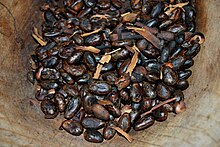
The first European knowledge about chocolate came in the form of a beverage which was first introduced to the Spanish at their meeting with
Culture
The
Gallery
-
kakaw (cacao) written in the Maya script
-
Floral diagram showing partial inflorescence
-
T. cacao, leaves, fruits and seed. A. Bernecker, 1864.
-
Young cacao trees, Côte d'Ivoire
-
Macrophotography of Theobroma cacao flower (closed)
-
Macrophotography of T. cacao flower (open)
-
Flowers
-
Cacao seed in the fruit or pocha
-
T. cacao fruit, dried
See also
- Ceratonia siliqua, the carob tree
- Kola nut
References
- ^ a b c d "Theobroma cacao L. Sp. Pl. : 782 (1753)". World Flora Online. World flora Consortium. 2022. Retrieved 14 December 2022.
- ^ "Mentha canadensis L." Plants of the World Online. Royal Botanic Gardens, Kew. 2022. Retrieved 14 December 2022.
- ^ "Theobroma cacao". Encyclopedia of Life. Archived from the original on 4 November 2012. Retrieved 9 November 2012.
- ^ "Cocoa". Drugs.com. 6 January 2020. Archived from the original on 20 January 2021. Retrieved 3 September 2020.
- ISBN 978-0-521-49346-8. Archivedfrom the original on 28 April 2021. Retrieved 16 September 2017.
- University of Wisconsin. Archived from the original on 4 October 2013. Retrieved 27 November 2012.)
{{cite journal}}: Cite journal requires|journal=(help - ^ S2CID 6858627.
- ^ Bell, Katie K. "Cacao Cocktails: A New Tequila-Like Spirit Distilled from Cacao Fruit". Forbes. Archived from the original on 28 April 2015. Retrieved 17 March 2015.
- ISBN 978-1-84973-912-2.
- ^ "Cacao". Etymology Online Dictionary, Douglas Harper. 2018. Archived from the original on 19 August 2018. Retrieved 19 August 2018.
- ^ PMID 18827930.
- ^ "History of cocoa (translated)". National Association of Exporters and Industrialists of Cacao of Ecuador. 2015. Archived from the original on 21 February 2018. Retrieved 20 February 2018.
- doi:10.3390/d2010072. Archivedfrom the original on 5 September 2019. Retrieved 5 September 2019.
- ^ PMID 23112832.
- ^ J. Bergmann (1969).
- ^ S. Coe (1994).
- ^ "Cocoa beans, area harvested in 2016, Crops/World regions/Cocoa beans/Area harvested from pick lists". United Nations Food and Agriculture Organization, Statistics Division (FAOSTAT). 2017. Archived from the original on 30 October 2018. Retrieved 28 January 2018.
- ^ "A strategy to safeguard the future of chocolate". Bioversity International. Archived from the original on 14 April 2013. Retrieved 9 November 2012.
- ^ "Varieties". All about Chocolate. Archived from the original on 2 July 2017. Retrieved 3 June 2017.
- ^ "Branding Matters: The Success of Chuao Cocoa Bean". Archived from the original on 3 March 2017. Retrieved 3 June 2017.
- ISSN 0963-9969.
- ^ PMID 28251656.
- ^ a b "Cocoa bean production in 2018, Crops/Regions/World list/Production Quantity (pick lists)". UN Food and Agriculture Organization, Corporate Statistical Database (FAOSTAT). 2019. Archived from the original on 30 October 2018. Retrieved 15 June 2020.
- ^ "Cacao Collections". CacaoNet. Archived from the original on 14 May 2015. Retrieved 9 November 2012.
- ^ "Global Strategy – cacaonet". sites.google.com. Archived from the original on 8 October 2018. Retrieved 19 July 2018.
- S2CID 3764608.
- PMID 28260703.
- ^ "Cocoa Crop Protection". Archived from the original on 9 February 2013. Retrieved 9 November 2012.
- ^ "Welcome to the Cacao Genome Project – Cacao Genome Database". Cacaogenomedb.org. Archived from the original on 20 July 2018. Retrieved 19 July 2018.
- ^ The International Cocoa Genome Sequencing Consortium federates efforts from circa 20 different institutions from six countries (France, USA, Côte d'Ivoire, Brazil, Venezuela and Trinidad et Tobago). Financing comes from several public and private sources from France, USA and Venezuela, among which the chocolate brands Valrhona (France) and Hershey's (USA). See : http://www.cirad.fr/actualites/toutes-les-actualites/communiques-de-presse/2010/decryptage-du-genome-du-cacaoyer Archived 16 January 2011 at the Wayback Machine
- S2CID 4685532.
- PMID 17721507.
- ^ Brodwin, Erin (31 December 2017). "Chocolate is on track to go extinct in 40 years". Business Insider, Inc. Archived from the original on 31 January 2018. Retrieved 31 January 2018.
- S2CID 53099825.
- ^ "Sweet discovery pushes back the origins of chocolate: Researchers find cacao originated 1,500 years earlier than previously thought". ScienceDaily. Retrieved 13 November 2018.
- ^ from the original on 15 September 2018. Retrieved 15 February 2011.
- PMID 18024588.
- ^ ""Cacao analysis dates the dawn of domesticated chocolate trees to 3,600 years ago", Eurekalert, October 24, 2018". Archived from the original on 24 October 2018. Retrieved 24 October 2018.
- ^ Kidder (1947).
- ^ Hammond and Miksicek (1981); Turner and Miksicek (1984).
- ^ Davis, Nicola (29 October 2018). "Origin of chocolate shifts 1,400 miles and 1,500 years". The Guardian. Archived from the original on 30 October 2018. Retrieved 31 October 2018.
- ^ (Coe and Coe 1996)
- ^ Alexander Walker (1822). Colombia, relación geográfica, topográfica, agrícola, comercial y política de este país: adaptada para todo lector en general y para el comerciante y colono en particular. Tomo II. Londres: Banco de la República, pp. 284.
- ^ (Bogin 1997, Coe 1996, Montejo 1999, Tedlock 1985)
- ^ (Coe 1996, Townsend 1992)
- PMID 10917925.
- ^ Head 1903, p. ii (frontispiece)
Further reading
- Coe, Sophie D. (1994). America's First Cuisines. Austin: University of Texas Press. ISBN 0-292-71155-7.
- Coe, Sophie D.; ISBN 0-500-01693-3.
- Dienhart, John M. (1997). "The Mayan Languages – A Comparative Vocabulary" (PDF). Odense University. Archived from the original (PDF) on 5 July 2007. Retrieved 14 February 2007.
- McNeil, Cameron, ed. (2006). Chocolate in Mesoamerica: A Cultural History of Cacao. Gainesville: University of Florida Press. ISBN 0-8130-2953-8.
- Bergmann, John (1969). "The Distribution of Cacao Cultivation in Pre-Columbian America". Annals of the Association of American Geographers. 59 (1): 85–96. JSTOR 2569524.
- Head, Brandon (1903). The Food of the Gods: A Popular Account of Cocoa. London: R. B. Johnson. p. ii.
- Motamayor, J. C.; Risterucci, A. M.; Lopez, P. A.; Ortiz, C. F.; Moreno, A.; Lanaud, C. (2002). "Cacao domestication I: the origin of the cacao cultivated by the Mayas". PMID 12399997.
- End, M. J.; Daymond, A. J.; Hadley, P. (2010). Technical Guidelines for the Safe Movement of Cacao Germplasm. Cacaonet – Bioversity International. Archived from the original on 10 May 2013. Retrieved 6 November 2012.
- Eskes, A. B.; Efron, Y., eds. (2006). Global Approaches to Cocoa Germplasm Utilization and Conservation. CFC – ICCO – IPGRI. Archived from the original on 10 May 2013. Retrieved 6 November 2012.
External links
- International Cocoa Organization (ICCO) – includes cacao daily market prices and charts

